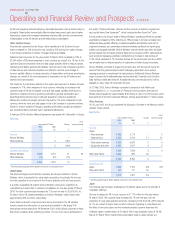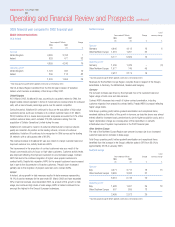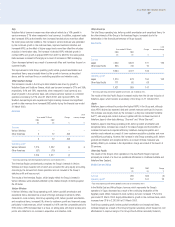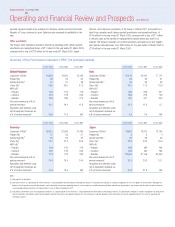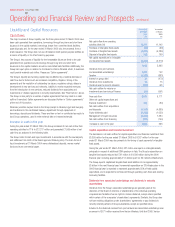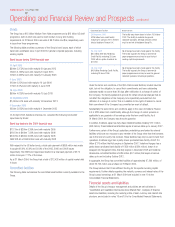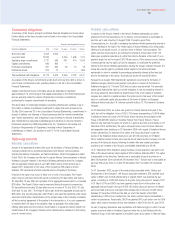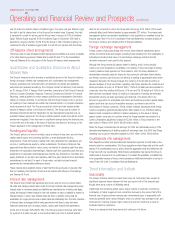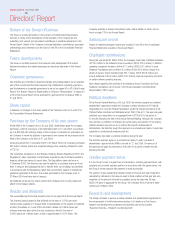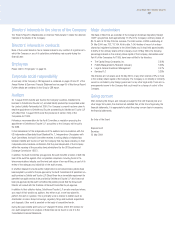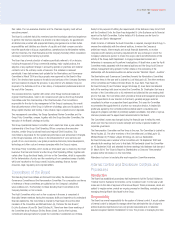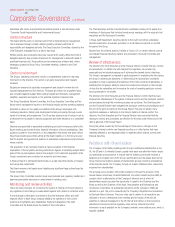Vodafone 2004 Annual Report Download - page 46
Download and view the complete annual report
Please find page 46 of the 2004 Vodafone annual report below. You can navigate through the pages in the report by either clicking on the pages listed below, or by using the keyword search tool below to find specific information within the annual report.
Vodafone Group Plc Annual Report 2004
44
Operating and Financial Review and Prospects continued
over its direct and indirect stake in Vodafone Egypt. The option will give Telecom Egypt
the right to put its shares back to the Group at fair market value. If agreed, this right
is expected to remain for as long as the Group owns in excess of 20% of Vodafone
Egypt. Telecom Egypt acquired 8.6% of Vodafone Egypt in December 2003 and is
expected to acquire a further 16.9% from the Group in 2004, thereby enabling it to
contribute 25.5% of Vodafone Egypt shares to a 50:50 joint venture with the Group.
Off-balance sheet arrangements
The Group does not use off-balance sheet special purpose entities as a source of liquidity
or for other financing purposes. Please refer to notes 26 and 27 to the Consolidated
Financial Statements for a discussion of the Group’s off-balance sheet arrangements.
Quantitative and Qualitative Disclosures About
Market Risk
The Group’s treasury function provides a centralised service to the Group for funding,
foreign exchange, interest rate management and counterparty risk management.
Treasury operations are conducted within a framework of policies and guidelines
authorised and reviewed annually by the Company’s Board of directors, most recently
on 20 January 2004. A Treasury Risk Committee, comprising of the Group’s Financial
Director, Company Secretary, Treasurer, Financial Controller and Director of Financial
Reporting, meets quarterly to review treasury activities and management information
relating to treasury activities. In accordance with the Group treasury policy a quorum
for meetings is four members and either the Financial Director or Company Secretary
must be present at each. The Group accounting function provides regular update
reports of treasury activity to the Board of directors. The Group uses a number of
derivative instruments that are transacted, for risk management purposes only, by
specialist treasury personnel. The Group’s internal auditors review the internal control
environment regularly. There has been no significant change during the financial year,
or since the end of the year, to the types of financial risks faced by the Group or the
Group’s approach to the management of those risks.
Funding and liquidity
The Group’s policy is to borrow centrally, using a mixture of long term and short term
capital market issues and borrowing facilities, to meet anticipated funding
requirements. These borrowings, together with cash generated from operations, are
on-lent or contributed as equity to certain subsidiaries. The Board of directors has
approved three debt protection ratios, being: net interest to operating cash flow (plus
dividends from associated undertakings); retained cash flow (operating cash flow plus
dividends from associated undertakings less interest, tax, dividends to minorities and
equity dividends) to net debt; and operating cash flow (plus dividends from associated
undertakings) to net debt. For each of these ratios, net debt includes financial
guarantees and redeemable preference shares.
These internal ratios establish levels of debt that the Group should not exceed other
than for relatively short periods of time and are shared with Moody’s, Fitch Ratings
and Standard & Poor’s.
Interest rate management
The Group’s main interest rate exposures are to euro and yen and, to a lesser extent,
US dollar and sterling interest rates. Under the Group’s interest rate management policy,
interest rates on monetary assets and liabilities are maintained on a floating rate basis,
unless the forecast interest charge for the next eighteen months is material in relation to
forecast results, in which case interest rates are fixed. In addition, fixing shall be
undertaken for longer periods when interest rates are statistically low. The term structure
of interest rates is managed within limits approved by the Board, using derivative
financial instruments such as swaps, futures, options and forward rate agreements.
At the end of the year, 20% (2003: 9%) of the Group’s gross borrowings were fixed
for a period of at least one year. A one hundred basis point rise in market interest
rates for all currencies in which the Group had borrowings at 31 March 2004 would
adversely affect profit before taxation by approximately £21 million. The interest rate
management policy has remained unaffected by the acquisitions completed during the
financial year. Note 19 to the Consolidated Financial Statements contains analysis of
the Group’s currency and interest profile of financial liabilities.
Foreign exchange management
Foreign currency exposures arising from known future external transactions above
certain de minimis levels are hedged, including those resulting from the repatriation of
international dividends and loans. Forward foreign exchange contracts are the
derivative instrument most used for this purpose.
Although the Group reports its balance sheet in sterling, which is the principal
currency for most transactions undertaken in its shares, it does not hedge its foreign
currency balance sheet exposure for three reasons. First, the Group believes its
shareholders principally value its shares by discounting its estimated future sterling
and foreign currency cash flows and converting to sterling at appropriate rates where
necessary. Secondly, the Group manages the currency of its net debt according to
banded multiples of those currencies’ operating cash flows, adjusted for dividends and
share purchases. As such, at 31 March 2004, 119% of net debt were denominated in
currencies other than sterling (59% euro, 57% yen and 3% US dollar) and 19% of net
debt had been purchased forward in sterling in anticipation of sterling denominated
shareholder returns via share purchases and dividends. This allows debt to be
serviced in proportion to anticipated cash flows and therefore provides a partial hedge
against profit and loss account translation exposure, as interest costs will be
denominated in foreign currencies. Thirdly, certain overseas businesses have foreign
currency acquisition goodwill allocated whilst other assets do not, therefore making
balance sheet comparisons difficult. A relative weakening in the value of sterling
against certain currencies of countries where the Group operates has resulted in a
currency translation adjustment charge of £5,292 million to Group reserves in the
year ended 31 March 2004 (2003: £9,039 million credit).
When the Group’s international net earnings for 2004 are retranslated using a 10%
strengthening/weakening of sterling against all exchange rates, the 2004 total Group
operating loss would be reduced/increased by £451 million (2003: £595 million).
Counterparty risk management
Cash deposits and other financial instrument transactions give rise to credit risks on the
amounts due from counterparties. The Group regularly monitors these risks and the credit
ratings of its counterparties and, by policy, limits the aggregate credit and settlement risk
it may have with one counterparty. While these counterparties may expose the Group to
credit losses in the event of non-performance, it considers the possibility of material loss
to be acceptable because of these control procedures. Additional information is set out in
notes 19 and 20 to the Consolidated Financial Statements.
Trend Information and Outlook
Seasonality
The Group’s financial results and cash flows have not, historically, been subject to
significant seasonal trends between the first and second half of the financial year,
though there are a number of offsetting trends.
Traditionally, the Christmas period sees a higher volume of customer connections,
contributing to higher equipment and connection revenues in the second half of the
financial year. Ongoing airtime revenues also demonstrate signs of seasonality, with
revenues generally lower during February, which is a shorter than average month, and
revenues from roaming charges higher during the summer months as a result of
increased travel by customers.
There is no assurance that these trends will continue in the future.


